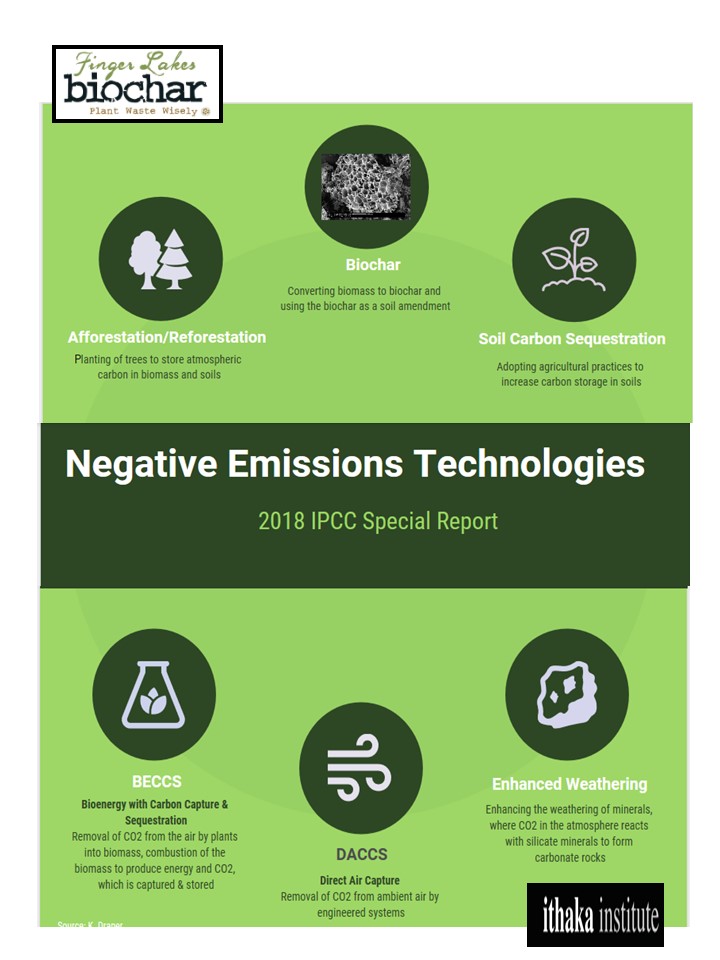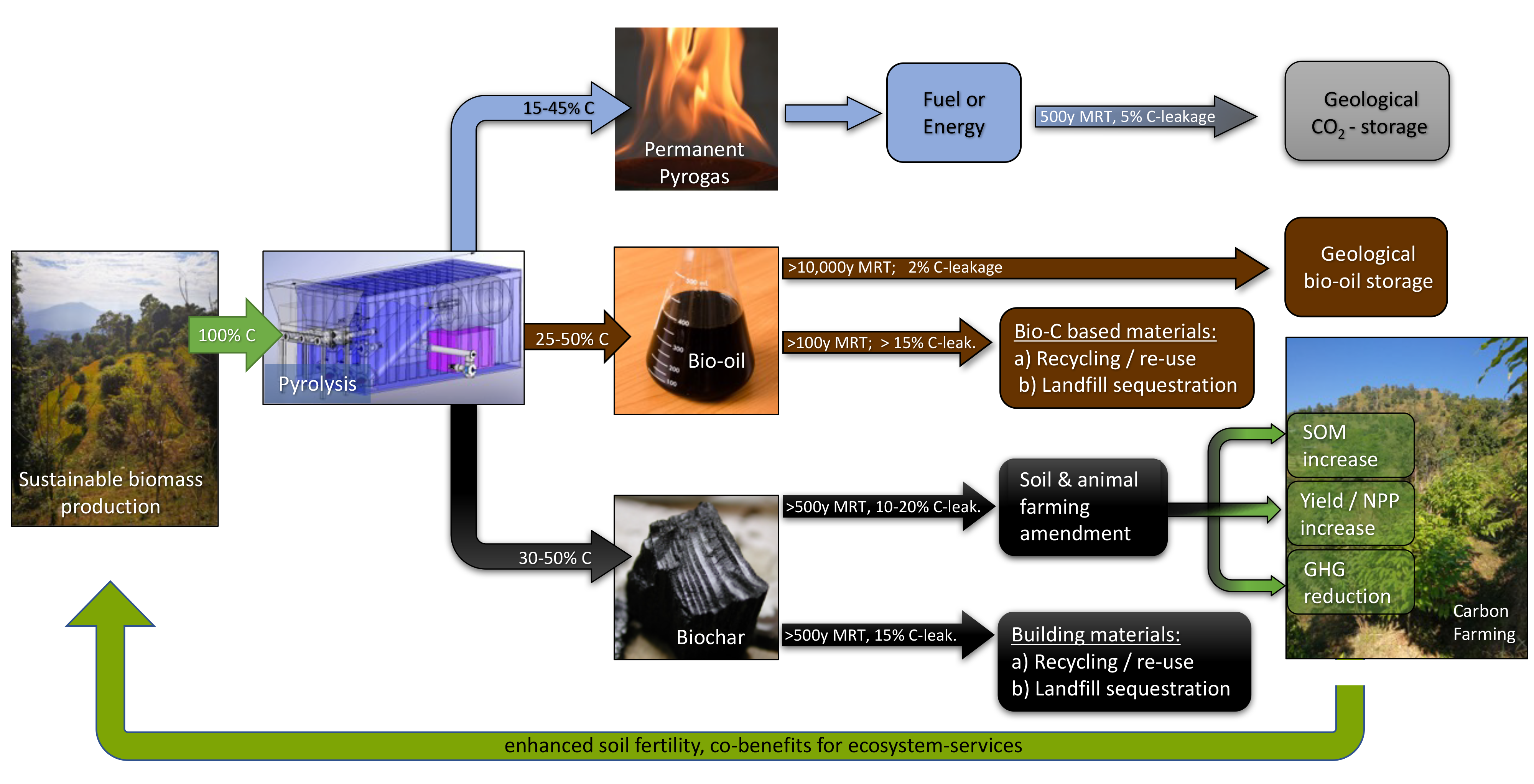The IPCC’s recent Special Report state’s that while steep and rapid emission reductions are critical, we have come to a point where carbon must be pro-actively pulled out of the air and stored safely elsewhere. Storage options are limited to land or oceans (though no doubt some would like a moonshot!). Land-based storage options include soils, deep geological storage or rocks – yes rocks!
The report lists a mere six Negative Emissions Technologies (NET) that they feel may be capable of drawing down massive amounts of carbon. Biochar, for the first time is included in that shortlist. To recap the sequestration mechanism offered by biochar: carbonizing underutilized organic material, be it sewage sludge, city green waste, storm debris, invasive species, food waste or myriad other sources, converts recently photosynthesized atmospheric carbon into stable, long-lasting carbon that can be stored in soils or safely incorporated into man-made materials.
Biochar, along with only two other NETs, afforestation/reforestation and soil carbon sequestration are ancient, proven processes which provide many other benefits beyond sequestration. The other three NETs; Bioenergy with Carbon Capture & Storage (BECCS), Direct Air Capture with Carbon Storage (DACCS), and Enhanced Weathering, have yet to be proven scalable, and may come with unintended consequences and enormous cost.

Figure 1: The six Negative Emission Technologies (NET) discussed in the latest IPCC special report.
A limiting factor for most of the proposed NETs is land. There is only so much bare land that can effectively be converted to forests, agricultural land that can store carbon without endangering food production or biodiversity, or remote lands that can safely store carbon captured from bioenergy production smoke stakes or pulled from thin air.
While the IPCC’s report lists soil (presumably agricultural) as biochar’s storage medium, this is not entirely accurate. Much of the earlier biochar research focused on agricultural uses in soils, but increasingly it is being shown that biochar can be put to good use in urban soils for storm water management or in contaminated soils (e.g. mine lands, brown fields, landfills etc.) thereby expanding the amount of land where biochar can be sequestered. Also, it is important to note, that biochar is increasingly being eyed as a material to put into various man-made materials as a means of displacing non-renewable, expensive or high carbon footprint materials. These products have productive lives above the soil before finding their way eventually into the soil. This includes many shorter-lived products such as kitty litter, bio-plastics or filtration carbon which may end up in landfills where it still sequesters carbon and may even reduce methane emissions. Longer-lived biochar-based products are gaining attention in the form of building materials which not only serve as carbon sinks but can provide insulation for housing and other environmental benefits.
Moreover, bio-oil, a liquid by-product of biochar production can equally be used to replace fossil fuel-based materials like plastics, composite materials or asphalt. The smart use of bio-oil can further increase the carbon sequestration potential of the biochar technology by more than 50%. This makes the biochar method (or pyrolytic carbon capture and storage (PyCCS) as it is also called) the by far most efficient and cost-efficient NET.

Figure 2: General PyCCS scheme for pyrolytical treatment of biomass, the pathways of solid, liquid, and gaseous products, their use and sequestration scenarios, the respective C-leakage rates, and the circular effect on carbon farming systems and sustainable biomass production.
One other thing to note with biochar is that it can increase the sequestration potential of both afforestation/reforestation and soil carbon sequestration. When used to plant trees, biochar can not only speed up growth, but it has been shown to provide increased resistance against disease pressure, so trees may live longer. While developing healthy forests, an abundance of residual forest biomass is produced which could provide the fodder for biochar which can then be put back into forest soils helping to further boost soil fertility and water management while sequestering more carbon.
Soil carbon sequestration includes changing destructive agricultural practices such as monoculture cropping and optimizing nutrient cycling to increase soil organic matter build-up. Combining biochar with other organic (nutrient rich) materials (e.g. manure, digestate, compost, etc.) can not only provide longer-term carbon sequestration, it can help hold onto nutrients longer which reduces other negative environmental impacts such as groundwater contamination, eutrophication and greenhouse gas emissions.
So as the need for carbon safety nets grows and our window of opportunity shrinks, let’s make sure we chose NETs that are in fact safe, sustainable and offer a high possibility of success. For a more in depth perspective of this topic, please have a read of this article on the Biochar Journal.
Representatives from the International Biochar Initiative (IBI) and the Ithaka Institute attended the recent United Nations Climate Change Conference (COP 24) in Poland. Despite the inclusion of biochar into the latest IPCC special report, we well knew that biochar’s capabilities to help communities adapt to climate change, reduce emissions and sequester carbon were not yet well known. However, it was shocking to see how ignorant the elite of climate change science and policy still is in regards to biochar. This is especially true for the entire aspect of biochar’s versatility in terms of the 55 uses of biochar to help individuals or industries, in both the developed and developing world, to reduce or eliminate greenhouse gas emissions and to eventually become carbon negative (= climate positive).
Following the world climate conference, we are thinking and discussing what will it take to quickly bring biochar and the other co-benefits from pyrolysis to the world’s attention? We really need to tell the world about the existing and emerging biochar stories of individuals and industries, of co-ops, communities and even countries that are leveraging biochar to cut carbon emissions while continuing to grow food and economies. There are an increasing number of successful biochar stories that need to get to and covered by the big media. We can deliver the facts and stories but we need to partner with media producers to get the facts and stories on the big screens and to make people in the streets talk about it. That’s our mission at IBI and at Ithaka.


Combining three of the best carbon capture technologies in one practice
We suggest that combining biochar with enhanced weathering in a land management strategy broadly titled "improved agricultural practices" or "regenerative land management", or "agro-forestry", or "land based climate mitigation" or some other moniker suitable to the geographic region and the practice, we can rapidly deploy at scale through "conventional" transport, materials handling and deployment methods. Rock Dust Local has been advocating for this approach for many years through remineralization, only in the last 10 years have we been aware of the extraordinary potential of including biochar production and deployment as a core technology and practice. See rockdustlocal.com. Regenerative farming and agro-forestry are suitable settings for these inputs and can increase the carbon holding capacities of soils through interaction with biology; bacteria and fungi. The potential downsides are overstated while the potential benefits are under-reported. We know this works because we are deploying the materials at scale and measuring the results. If the IPCC believes its own rhetoric these technologies and practices should be immediately deployed, and ramped up at global scale, without fail. By doing so we will gain much more than we will lose in both CO2 and CO2e (N2O, CH4, etc.) capture, as well as knowledge. Farmers and foresters practicing biologic methods are astute at figuring out what works and what does not. We can do this! Thomas Vanacore/ CEO Rock Dust Local/ Bridport VT USA